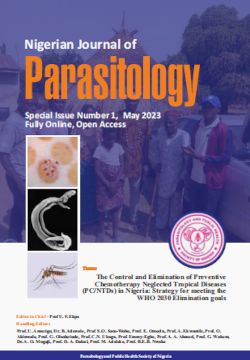Evaluation of malaria parasites in relation to Blood Groups among participants attending tertiary health facility, Sokoto State, Nigeria
https://dx.doi.org/10.4314/njpar.v42i2.9
Keywords:
Malaria, ABO blood group, Patients and SokotoAbstract
Malaria is still considered a major public health problem and a leading cause of morbidity and mortality in developing countries of the world especially Africa, which Nigeria is among. Studies were conducted to evaluate malaria parasites in blood group of 440 consented participants in Sokoto Specialist Hospital. Blood samples were collected from each of the participants, and examined parasitologically using the thick and thin blood techniques. Overall 69.09 percent of malaria prevalence was recorded. It was statistically observed to be higher but insignificant in males (71.43%) than in females (69.96%) while the result of malaria prevalence according to age group of the subjects showed a significant difference (P<0.05), age group <5 years (76.08%) had the highest prevalence and age group >45 years (51.43%) had the lowest prevalence of malarial infection. Chi-square test revealed a significant difference (P<0.05) of susceptibility of malaria, subjects with blood group O (73.24%) had the highest prevalence of malarial infection compared to blood group B (65.22%) and then blood group A (33.33%). This study therefore, revealed a high prevalence of malaria parasite infection in the study area, which indicated a high risk of morbidity and mortality in the area and that individuals with ABO blood group O are more vulnerable to malarial infection. Therefore, in a bid to save lives, this research recommended for a holistic approach in the fight against malaria infection, which will aid the molecular and genetic understanding for how malaria health policy would be evidence-based in the control of disease and enhanced public enlightenments is also recommended.
References
World Health Organization (2010). World m a l a r i a r e p o r t , G e n e v a . http://www.who.int/malaria,wmwr2010/ma laria 2010. pdf.
World Health Organization (2015). World M a l a r i a R e p o r t 2 0 1 5 . http://www.who.int/malaria/publications/w o r l d - r e p o r t - 2 0 1 5 / e n / I S B N : 9789241565158.
World Health Organization (2017). World Malaria Report 2017; ISBN 978-92-4- 156552-3. Pp32-38.
World Health Organization (2015). Malaria i n c h i l d r e n u n d e r f i v e . http://www.who.int/malaria/areas/high_risk _groups/children/en/
World Health Organization (2014). Malaria Factsheet N0. 94. Updated December, 2014. www.who.int/malaria/media/world-malaria report - 2014.
World Health Organizatiuon (2011). WHO Global Malaria Report 2011. Pp248 ISBN 9781:9241564403.
World Health Organization (2000). Malaria diagnosis new perspectives. Report of a joint WHO/USAID informal consultation 25-27 October, 1999, Technical Report Series NO. 743. Geneva. PP:57.
Sokoto Specialist Hospital Management, (2017). Verbal communication with the EO: About the hospital.23/6/2017.
National Population Commission (2006). Nigerian Population Census Report 2006. R e t r i e v e d f r o m http://www.population.gov.ng/index.
Canbak D. (2008). Canbak Income Global Distribution Database Wikipedia, the Free Encyclopedia. 08-20.
Cheesbrough, M. (2000). District Laboratory Practice in Tropical Countries. Cambridge University Press, Cambridge. Part 1 12. Cheesebrough, M. (2006). District Laboratory Practice in Tropical Countries, Part 1. University Press, Cambridge, pp 239- 258
Centre for Disease Control (2015). Malaria diagnosis and treatment (United States) – Guidelines for treatment of malaria focusing o n s p e c i e s i d e n t i f i c a t i o n . https://www.cdc.gov.malaria>clinicians2.
Malomgre, W., and Neumeister, B. (2009). Recent and future trends in blood group typing.Annasl and Bioannals of Chemicals.; 393:1443-1451.doi:10.1007/s00216-008- 3.[pubmed][Cross Ref].
Oparaocha, E.T. (2003). The impact of haemoglobin level and concomitant infection of malaria parasitaemia and on-set of fever during malaria attack in Ikwuano Local Government Area of Abia State, Nigeria. Nigerian Journal of Parasitology. 24:25-32.
Aribodor, D.N., Njoku, O.O., Eneanya, C.A. and Onyali, I.O. (2003). Studies on prevalence of malaria and management practices of Azia Community of Anmbra State, South-East Nigeria. Nigeria Journal of Parasitology. 24:33-38.
Aribodor, D.N., Udeh, A.K., Ekwunife, C.A., Aribodor, O.B. and Emelummadu, O.F. (2014). Malaria Prevalence and Local Beliefs in Transmission and Control in Ndiowu Community, Anambra State. Nigeria. Nigerian Journal of Parasitology. 35 (1 and 2):103-108.
Ejezie, G.C. (1983). The Nigerian environment and parasitic infection. Folia Parasitology. (PRAHA), 30:80-95.
Kalu, M.K., Nwogo, A.O., Florence, O.N. and Glory, O. (2012). A Comparative Study of the Prevalence of Malaria in Abia and Umuahia Urban Areas of Abia State, Nigeria. Research Journal of Parasitology. 7(1):17-24.
Fatima, A.I. (2016). Haematological and humoral response to malaria among children under five years of age attending General Hospital Kankia, Katsina State. M. Sc. Dissertation, UDUS.
Nwaorgu, O.C. and Orajaka, B.N. (2011). Prevalence of malaria among children 1- 10years old in communities in Awka North Local Government Area, Anambra State South- East Nigeria. African Research Review. 5(5):264- 281.
Yahaya, A., Aminu, F. and Tukur, A.I. (2012). Seasonal Variation of Malaria Infection among Out-Patients Attending Wudil General Hospital, Kano State, Nigeria. International Journal of Applied Research and Technology. 7:79 – 84.
Ebrahim, G.J. (1978). Practical mother and child health in developing countries. Macmillan Press Ltd. London, pp46-55.
Luzzato, L. (1979). Genetics of red blood cells and susceptibility to malaria. Blood, 54:961-976.
Tela, I.A., Modibbo, M.H.,Adamu, L.H. and Taura, M.G. (2015). Prevalence of malaria infection among ABO blood groups in Jamaˈare, Nigeria. RA Journal of Applied Research. Vol. 1(e):2394-6709. Pp255-262.
Opara, K.N., Atting, I.A., Ukpong, I.G., Nwabueze, A.A. and Inokon, I.I. (2006). Susceptibility of genetic indices to falciparum malaria in infants and young children in Southern Nigeria. Pakistan. Journal of Biological Sciences. 9(3):452- 456. ISSN 1028-8880.
Paul, E.O., Wim, V.B., Anatol, M.B., Anne, C., Patricia, R., Ambrose, T., Umberto, D. and Marc, C. (2002). Variation in Malaria Transmission Intensity in Seven Sites throughout Uganda. American Journal of Tropical Medicine and Hygiene. 75(2):219- 225.
Downloads
Published
How to Cite
Issue
Section
License
Copyright (c) 2023 Nigerian Journal of Parasitology

This work is licensed under a Creative Commons Attribution-NonCommercial-NoDerivatives 4.0 International License.




